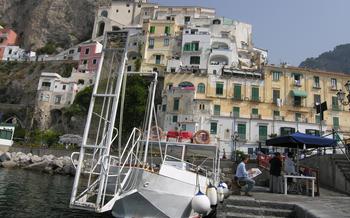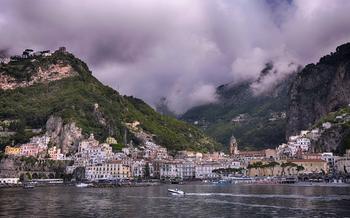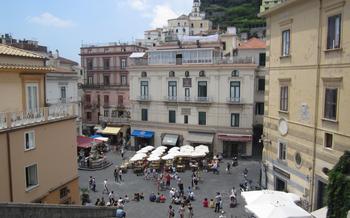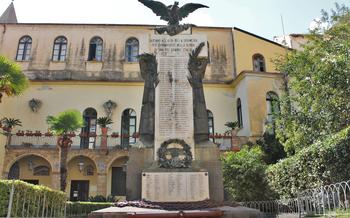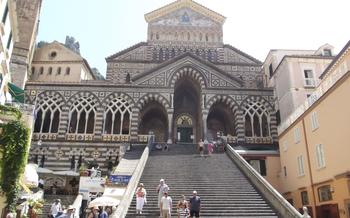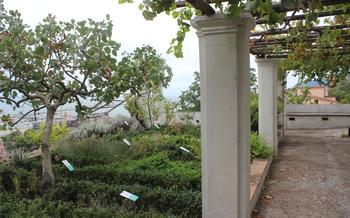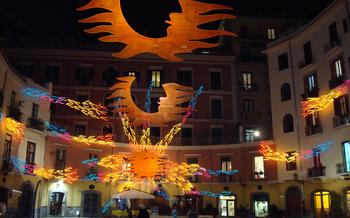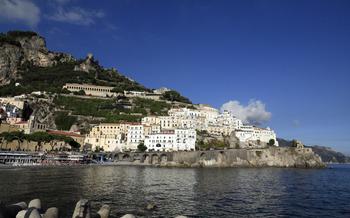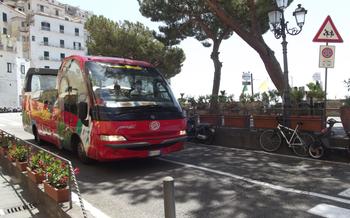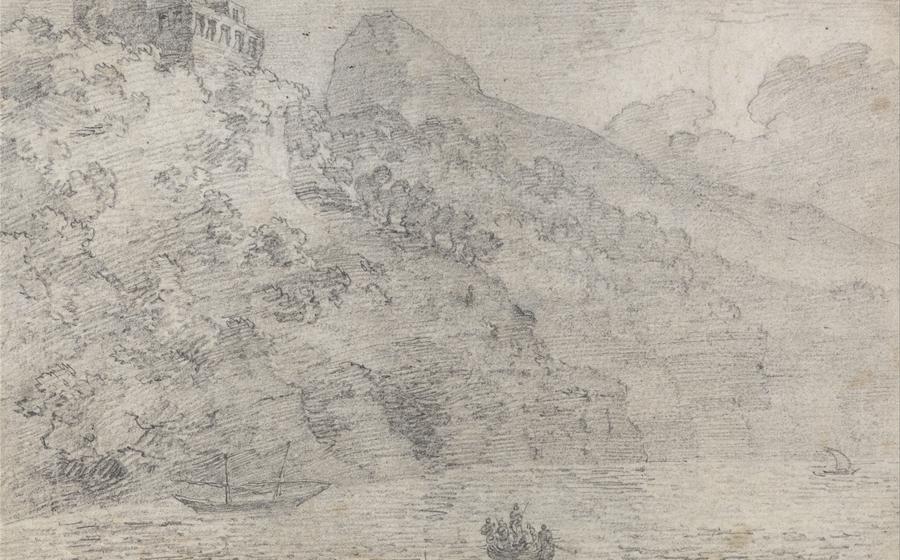
Amalfi Coast Museum of Paper
- Historical Context
- Location and Accessibility
- Museum Layout and Exhibits
- Papermaking Process Demonstration
- The Amalfi Paper Mill: A Vestige of Tradition
- Watermarks and Their Importance
- Paper Restoration and Conservation
- Educational Programs
- Visitor Amenities
- Admission and Timings
- Photography and Videography
- Accessibility for Visitors with Disabilities
- Nearby Attractions: Unveiling Amalfi's Hidden Gems
- Insider Tip: Unveiling the History and Techniques of Papermaking
Historical Context
Amalfi's papermaking history dates back to the 13th century when it emerged as a leading center of paper production in Europe. The town's unique location, with its abundant water resources and access to trade routes, made it an ideal place for the development of this crucial industry.
Amalfi's papermakers refined the techniques of papermaking, introducing the innovative use of linen and cotton rags as raw materials. This innovation resulted in the creation of a stronger, more durable, and whiter paper known as "laid paper." Laid paper revolutionized the world of writing and printing, as it provided a superior surface for writing and allowed for the mass production of books.
The Amalfitan paper industry flourished throughout the Middle Ages, and its paper became renowned for its exceptional quality and durability. Amalfi paper was exported throughout Europe and beyond, contributing to the spread of knowledge and the development of printing. However, with the rise of other papermaking centers and advancements in technology, the industry in Amalfi gradually declined. Despite the decline, the legacy of Amalfi's papermaking tradition lives on, preserved and celebrated at the Amalfi Coast Museum of Paper.
Location and Accessibility
The Amalfi Coast Museum of Paper is situated in the heart of Amalfi, a charming town on the picturesque Amalfi Coast. Visitors can easily reach the museum by foot from the center of town or by taking a short bus ride from nearby villages. The museum is conveniently located near other top attractions in Amalfi, such as the Amalfi Cathedral, the Piazza del Duomo, and the Museo Civico di Amalfi.
For those arriving by car, there are several public parking lots within walking distance of the museum. It's essential to note that Amalfi's streets are narrow and winding, so navigating by car can be challenging.
The museum is wheelchair accessible, with ramps and elevators providing access to all levels. Visitors with disabilities can also request assistance from the museum staff.
Museum Layout and Exhibits
The Amalfi Coast Museum of Paper is housed in a 13th-century former paper mill, providing a unique and atmospheric setting for its exhibits. The museum is divided into several sections, each dedicated to a different aspect of papermaking history and technology.
In the first section, visitors can learn about the history of papermaking in Amalfi and see ancient tools and equipment used by papermakers centuries ago. The second section showcases a collection of early printed books and manuscripts, demonstrating the impact of paper on the spread of knowledge and culture.
The third section is dedicated to the traditional papermaking process, with interactive exhibits and demonstrations that allow visitors to experience the craft firsthand. Visitors can watch skilled artisans create sheets of paper using the same techniques that were used in medieval times, from preparing the pulp to drying and pressing the sheets.
Finally, the museum has a section devoted to contemporary papermaking, showcasing innovative techniques and modern applications of paper. Visitors can see examples of handmade paper used in art, design, and fashion, demonstrating the enduring legacy of this ancient craft.
Papermaking Process Demonstration
The Amalfi Coast Museum of Paper offers visitors a rare opportunity to witness the ancient art of papermaking in action. Live demonstrations are held regularly, providing an immersive experience that allows visitors to see firsthand the intricate steps involved in creating a sheet of paper.
During the demonstration, skilled artisans recreate the traditional papermaking process using the same techniques and materials that were employed centuries ago. Visitors can observe the transformation of raw materials, such as linen and cotton rags, into a smooth and durable sheet of paper.
The demonstration begins with the preparation of the pulp, which involves soaking the rags in water and beating them into a fibrous slurry. The pulp is then poured into a mold, which is a wooden frame covered with a wire mesh. The mold is shaken gently to distribute the pulp evenly and create a thin layer.
Once the water has drained, the papermaker carefully transfers the wet sheet onto a felt cloth. Multiple layers of paper and felt are stacked together and pressed to remove excess water and create a smooth surface.
The final step is drying, which is done by hanging the sheets of paper in a warm, airy room. As the paper dries, it shrinks and becomes strong and flexible.
The demonstration not only provides a fascinating glimpse into the history of papermaking but also highlights the skill and artistry of the papermakers who have preserved this ancient craft for generations.
The Amalfi Paper Mill: A Vestige of Tradition
In the heart of the Amalfi Coast, nestled between the charming town of Amalfi and the picturesque village of Pontone, lies a testament to the region's rich papermaking heritage: the Amalfi Paper Mill. Established in the 13th century, this mill is not merely a relic of the past but a living, breathing embodiment of traditional papermaking techniques that have been passed down through generations.
The Amalfi Paper Mill's history is intertwined with the rise and fall of the paper industry in Amalfi. During the Middle Ages, Amalfi was renowned as a major center of paper production, and its paper was highly sought after for its exceptional quality and durability. The mill's location on the banks of the Canneto River provided a steady supply of water, essential for the papermaking process.
Over the centuries, the mill has undergone renovations and modernizations, but it has remained faithful to the time-honored methods of papermaking. Visitors to the mill can witness the entire process, from the preparation of the pulp to the drying and pressing of the sheets.
Guided tours of the mill offer a fascinating glimpse into the intricate steps involved in creating handmade paper. Visitors can observe skilled artisans transforming humble linen and cotton rags into pristine sheets of paper, using the same techniques that were employed centuries ago.
The mill's production is not limited to papermaking alone. It also produces a range of high-quality handmade paper products, including stationery, notebooks, and greeting cards. These products, adorned with the mill's distinctive watermark, are available for purchase at the mill's gift shop, allowing visitors to take home a piece of Amalfi's papermaking legacy.
Watermarks and Their Importance
Watermarks are an intriguing aspect of Amalfi papermaking that not only add to its aesthetic appeal but also played a crucial role in its history. These distinctive designs or symbols embedded in the paper during the manufacturing process served as a unique identifier, much like a signature or logo. They were commonly used by paper mills to mark their products and establish their reputation for quality.
The Amalfi Coast Museum of Paper showcases a collection of documents and manuscripts that beautifully illustrate the intricate and diverse watermarks found in Amalfi paper. From simple lines and shapes to elaborate coats of arms and family crests, these watermarks tell stories of the paper's origin, its maker, and its intended purpose.
In the early days of papermaking, watermarks served as a form of authentication and protection against counterfeiting. By incorporating a unique watermark into their paper, papermakers could ensure that their products were easily identifiable and could not be easily replicated by others. This was particularly important for legal documents, financial transactions, and other official records, where authenticity was paramount.
The study of watermarks has become a valuable tool for historians, researchers, and collectors, providing insights into the history of papermaking, trade routes, and cultural exchanges. By analyzing the watermarks found in old documents and manuscripts, experts can determine the date and place of their production, as well as the paper mill or workshop that created them.
The Amalfi Coast Museum of Paper offers visitors a fascinating glimpse into the world of watermarks, highlighting their significance in the history of papermaking and their role in preserving cultural heritage.
Paper Restoration and Conservation
The Amalfi Coast Museum of Paper is dedicated to preserving and restoring historical documents and manuscripts made from Amalfi paper. The museum's conservation laboratory is equipped with state-of-the-art technology and staffed by skilled professionals who use a variety of techniques to repair and restore damaged paper. These techniques include cleaning, deacidification, and mending tears. The museum also works closely with other institutions to develop new and innovative conservation methods.
By preserving cultural heritage through the conservation of old and fragile documents, the Amalfi Coast Museum of Paper plays a vital role in ensuring that future generations can continue to learn from and appreciate the region's rich papermaking history. The museum's conservation efforts also help to raise awareness of the importance of preserving cultural heritage and the need to protect our shared history.
Educational Programs
The Amalfi Coast Museum of Paper is committed to promoting the study and appreciation of papermaking history and techniques through a variety of educational programs and workshops. These programs are designed for students, researchers, and the general public, offering hands-on learning experiences and in-depth exploration of the papermaking process.
For students, the museum offers guided tours that delve into the history of papermaking in Amalfi and the significance of the region's papermaking heritage. Workshops on papermaking techniques provide students with a hands-on experience, allowing them to create their own sheets of paper using traditional methods.
Researchers can benefit from the museum's extensive collection of historical documents and artifacts, which are available for study and research purposes. The museum's staff is available to assist researchers with their inquiries and provide guidance on accessing the collection.
The general public can participate in workshops and demonstrations that allow them to experience the papermaking process firsthand. These workshops are designed to be interactive and engaging, providing a fun and educational experience for visitors of all ages.
Visitor Amenities
The Amalfi Coast Museum of Paper offers a range of amenities to enhance visitors' experience and cater to their needs. Guided tours are available in several languages, including English, Italian, French, and German. Visitors can book these tours in advance to ensure a spot and avoid waiting. The museum also has a gift shop where visitors can purchase souvenirs, handmade paper products, and books related to papermaking, including historical texts and modern publications. The gift shop provides a unique opportunity to take home a piece of Amalfi's papermaking heritage. Additionally, the museum offers restrooms and a cloakroom for storing luggage, providing convenience and peace of mind for visitors.
Admission and Timings
Visiting the Amalfi Coast Museum of Paper is an enriching experience that offers insights into the region's papermaking heritage and its impact on global culture. The museum charges a modest entrance fee to cover maintenance costs and preserve its collection. However, students, seniors, and families can enjoy discounted rates, making it accessible to visitors of all backgrounds.
The museum observes specific opening hours to ensure proper upkeep and provide a quality experience for visitors. Generally, it is open from 9 am to 5 pm, allowing ample time to explore the exhibits and participate in interactive activities. However, it is advisable to check the museum's website or contact them directly for any seasonal variations in the schedule or special events that may affect the operating hours.
To avoid crowds and guarantee a more enjoyable visit, it is recommended to plan your visit outside of peak tourist season, typically from November to March. During these quieter months, you can immerse yourself in the museum's collection without feeling rushed and engage with the exhibits at your own pace.
Photography and Videography
The Amalfi Coast Museum of Paper welcomes photography and videography for personal and educational purposes. However, to ensure a respectful and enjoyable experience for all visitors, there are a few guidelines to keep in mind. Flash photography is not permitted within the museum as it can damage the delicate artifacts on display. Tripods and other bulky equipment are also discouraged to avoid obstructing the paths of other visitors.
Visitors are encouraged to capture the beauty and history of the exhibits through their lenses, but they should do so discreetly and without disturbing others. Taking candid shots of fellow visitors is not appropriate, and it is essential to respect their privacy. Additionally, any commercial photography or videography requires prior permission from the museum's management.
By following these guidelines, visitors can document their visit to the Amalfi Coast Museum of Paper while preserving the integrity and ambiance of the space for everyone to appreciate.
Accessibility for Visitors with Disabilities
The Amalfi Coast Museum of Paper is committed to ensuring that all visitors, regardless of their abilities, can enjoy the museum's exhibits and programs. The museum is wheelchair accessible, with ramps and elevators providing access to all levels. Audio guides are available for visitors with visual impairments, and sign language interpretation can be arranged in advance for visitors with hearing impairments. Additionally, the museum staff is trained to assist visitors with disabilities and can provide assistance with navigating the exhibits and participating in activities. Visitors with disabilities are encouraged to contact the museum in advance to discuss their needs and make arrangements for assistance.
Nearby Attractions: Unveiling Amalfi's Hidden Gems
After immersing yourself in the world of papermaking at the Amalfi Coast Museum of Paper, take some time to explore the town of Amalfi and its surrounding treasures. Just a short stroll from the museum, you'll find the Amalfi Cathedral, a stunning example of Norman-Arab architecture with its imposing bell tower and intricate mosaics.
For a breathtaking panoramic view of the town and the coastline, climb the steps to the Giardino della Minerva, a beautiful public garden perched on a hilltop. Admire the lush Mediterranean flora and take in the mesmerizing views of the azure sea and the colorful buildings of Amalfi.
Foodies will delight in Amalfi's culinary scene, with its abundance of fresh seafood, homemade pasta, and traditional Italian delicacies. Indulge in a leisurely lunch at one of the many charming restaurants along the picturesque waterfront, savoring the flavors of the region while enjoying the vibrant atmosphere.
If you're seeking a unique and immersive experience, consider booking a guided boat tour to explore the hidden coves and grottos along the Amalfi Coast. Marvel at the stunning rock formations, swim in crystal-clear waters, and discover secluded beaches accessible only by sea.
To discover the region's rich history, visit the Museo Civico di Amalfi, which houses an impressive collection of artifacts and documents that shed light on the town's maritime and trading past.
Amalfi is truly a place that offers something for everyone. Whether you're a history buff, a nature lover, or a culinary enthusiast, you'll find plenty to see and do in this charming town. So, take your time, wander its narrow streets, and uncover the many hidden gems that Amalfi has to offer.
Insider Tip: Unveiling the History and Techniques of Papermaking
For an immersive experience that brings the art of papermaking to life, join the museum's guided tour. Led by knowledgeable and passionate guides, these tours offer an in-depth exploration of the museum's exhibits and provide fascinating insights into the history, techniques, and significance of papermaking in Amalfi. Visitors will have the opportunity to trace the evolution of the craft from its ancient origins to modern-day practices, gaining a deeper appreciation for the skill and artistry involved. The guides will also demonstrate the traditional papermaking process using period tools and materials, allowing visitors to witness firsthand how these beautiful sheets of paper were created centuries ago.
